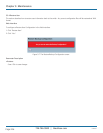
724-746-5500 | blackbox.com
724-746-5500 | blackbox.com
Page 215
Appendix
IMAP is the protocol that IMAP clients use to communicate with the servers, and SMTP is the protocol used to transport mail to
an IMAP server.
The current version of the Internet Message Access Protocol is IMAP4. It is similar to Post Office Protocol version 3 (POP3), but
offers additional and more complex features. For example, the IMAP4 protocol leaves your e-mail messages on the server rather
than downloading them to your computer. If you wish to remove your messages from the server, you must use your mail client
to generate local folders, copy messages to your local hard drive, and then delete and expunge the messages from the server.
IP: IP is an acronym for Internet Protocol. It is a protocol used for communicating data across an Internet network.
IP is a “best effort“ system, which means that no packet of information sent over is assured to reach its destination in the same
condition it was sent. Each device connected to a Local Area Network (LAN) or Wide Area Network (WAN) is given an Internet
Protocol address, and this IP address is used to identify the device uniquely among all other devices connected to the network.
The current version of the Internet protocol is IPv4, which has 32-bit Internet Protocol addresses allowing for in excess of four
billion unique addresses. This number is reduced drastically by the practice of Webmasters taking addresses in large blocks, the
bulk of which remain unused. There is a rather substantial movement to adopt a new version of the Internet Protocol, IPv6,
which would have 128-bit Internet Protocol addresses. This number can be represented roughly by a three with thirty-nine
zeroes after it. However, IPv4 is still the protocol of choice for most of the Internet.
IPMC: IPMC is an acronym for IP MultiCast.
IP Source Guard: IP Source Guard is a secure feature used to restrict IP traffic on DHCP snooping untrusted ports by filtering
traffic based on the DHCP Snooping Table or manually configured IP Source Bindings. It helps prevent IP spoofing attacks when
a host tries to spoof and use the IP address of another host.
LACP: LACP is an IEEE 802.3ad standard protocol. The Link Aggregation Control Protocol, allows bundling several physical ports
together to form a single logical port.
LLC: The IEEE 802.2 Logical Link Control (LLC) protocol provides a link mechanism for upper layer protocols. It is the upper
sub-layer of the Data Link Layer and provides multiplexing mechanisms that make it possible for several network protocols (IP,
IPX) to coexist within a multipoint network. LLC header consists of 1-byte DSAP (Destination Service Access Point), 1-byte SSAP
(Source Service Access Point), 1 or 2 bytes Control field followed by LLC information.
LLDP: LLDP is an IEEE 802.1ab standard protocol. The Link Layer Discovery Protocol (LLDP) specified in this standard allows
stations attached to an IEEE 802 LAN to advertise, to other stations attached to the same IEEE 802 LAN, the major capabilities
provided by the system incorporating that station, the management address or addresses of the entity or entities that provide
management of those capabilities, and the identification of the station’s point of attachment to the IEEE 802 LAN required by
that management entity or entities. The information distributed via this protocol is stored by its recipients in a standard
Management Information Base (MIB), making it possible for the information to be accessed by a Network Management System
(NMS) using a management protocol such as the Simple Network Management Protocol (SNMP).
LLDP-MED: LLDP-MED is an extension of IEEE 802.1ab and is defined by the telecommunication industry association (TIA-1057).
LOC: LOC is an acronym for Loss Of Connectivity and is detected by a MEP. It indicates lost connectivity in the network. Can be
used as a switch criteria by EPS.
MAC Table: Switching of frames is based upon the DMAC address contained in the frame. The switch builds up a table that
maps MAC addresses to switch ports for knowing which ports the frames should go to (based upon the DMAC address in the
frame). This table contains both static and dynamic entries. The static entries are configured by the network administrator if the
administrator wants to do a fixed mapping between the DMAC address and switch ports. The frames also contain a MAC
address (SMAC address), which shows the MAC address of the equipment sending the frame. The SMAC address is used by
the switch to automatically update the MAC table with these dynamic MAC addresses. Dynamic entries are removed from the
MAC table if no frame with the corresponding SMAC address have been seen after a configurable age time.
MD5: MD5 is an acronym for Message-Digest algorithm 5. MD5 is a message digest algorithm, used cryptographic hash function
with a 128-bit hash value. It was designed by Ron Rivest in 1991. MD5 is officially defined in RFC 1321 - The MD5 Message-
Digest Algorithm.
LGB1108A


















